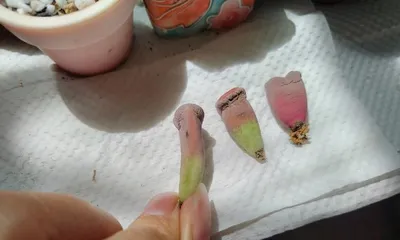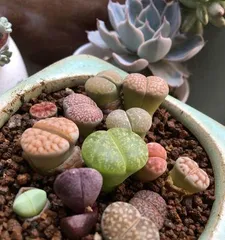What to do when Lithops are wilting

Lithops are a highly ornamental plant, but during the care process, you often encounter some problems, such as wilting. This article will introduce the care techniques for Lithops and methods to solve problems.
One: Correct watering is key
The watering technique for Lithops is very important. Generally, you should follow the principle of small amounts and frequent watering, but at the same time, you need to be careful not to water too much each time to avoid waterlogging the soil.

Two: Suitable temperature and humidity
Lithops need suitable temperature and humidity to grow strong. The growing environment should be maintained between 15°C and 25°C, and the relative humidity should be controlled at around 60% to 80%. You can increase the environmental humidity by spraying water.
Three: Choosing the right fertilizer
Lithops have a relatively low demand for fertilizer. If you choose a fertilizer that is too strong, it can easily damage the plant. It is recommended to use organic fertilizers, such as well-rotted chicken manure, well-rotted fish emulsion, etc. Fertilizing once a month is sufficient.
Four: The importance of light and ventilation
Lithops need sufficient sunlight to grow strong, but at the same time, they need to avoid strong, direct sunlight. It is also necessary to maintain a good ventilation environment to increase air circulation.

Five: How to prevent and control Lithops pests and diseases
Lithops are susceptible to pests such as aphids and whiteflies. If this occurs, timely control measures should be taken. You can use biological or chemical pesticides for control.
Six: How to deal with poor growth of Lithops
If you find that your Lithops are growing poorly, it may be due to reasons such as soil that is too dry or too wet, or a lack of light. You need to take appropriate measures to solve the problem based on the specific situation.
Seven: How to prune Lithops
Lithops grow quickly and can easily spread, so they need to be pruned appropriately. You can use pruning shears to trim the branches and leaves, trying to keep the main stem as much as possible.
Eight: How to propagate Lithops
Lithops can be propagated by methods such as cuttings and division. Before propagating, you need to make preparations, such as selecting healthy plants and preparing suitable soil.
Nine: Common problems and solutions for Lithops
During the care process, Lithops are prone to some problems, such as root rot and curled leaves. Corresponding solutions need to be taken to address these problems.
Ten: Introduction to common Lithops varieties
Lithops is a plant with many varieties. Common varieties include Pine-cypress stone flower, Begonia stone flower, and Radish stone flower. Each variety has its own special care requirements.
Eleven: The aesthetic role of Lithops
In addition to their ornamental value, Lithops can also play a certain role in beautifying the environment. They can be planted indoors or outdoors to make the environment more comfortable.
Twelve: The cultural connotation of Lithops
Lithops hold an important place in traditional Chinese culture and have been given many meanings and symbols. For example, giving them to friends represents lasting friendship and mutual support.
Thirteen: Learning to appreciate the beauty of Lithops
Lithops are not just an ornamental plant, but also a culture and a spirit. Learning to appreciate the beauty of Lithops can allow us to better experience the beauty of life.
Fourteen: Future development trends of Lithops
As people pay more and more attention to environmental protection and greening, Lithops will receive wider application and promotion in the future. It is believed that Lithops will become an indispensable part of people's lives.
Fifteen: Lithops care tips
This article has detailed the care techniques for Lithops and methods to solve problems from aspects such as watering, temperature and humidity, fertilizer selection, light and ventilation, pest and disease control, pruning, and propagation. We hope this can provide some useful reference for enthusiasts.